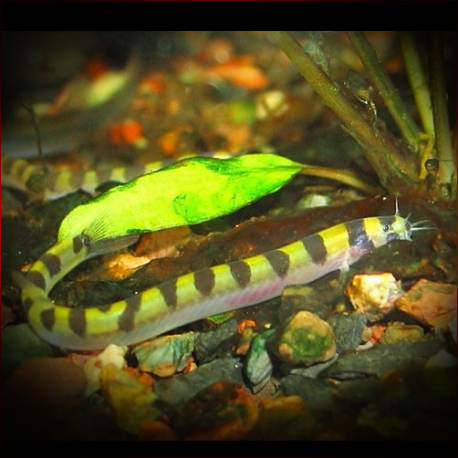More info
Datasheet
| Minimum Tank Size | 40 litres / 10.57 US gallons |
| Maximum Size | 4.0cm / 1.57inches |
| Temperature | 21°C / 69.80°F - 26°C / 78.80°F |
| Hardness | 0.00dgH / 0ppm - 8.01dgH / 143ppm |
| pH | 3.5-7.0 |
General Description
Pangio Cuneovirgata, also known as Acanthophthalmus cuneovirgatus Raut, is a species of loach belonging to the family Cobitidae. It is a small fish, typically reaching a maximum size of 4.0cm. The species is characterized by its long nasal barbels pierced at the base by anterior nostrils, truncate caudal-fin, and distinct coloration patterns consisting of dark saddles on the upper half of the body and a black blotch at the base of the caudal-fin.
Aquarium Setup
For a Pangio Cuneovirgata tank setup, it is recommended to provide a soft, sandy substrate to accommodate their digging behavior. Coarser gravel should be avoided as it may cause stress and inhibit feeding. Incorporating driftwood, roots, branches, and dried leaf litter can create ample shaded areas and mimic natural habitats. Dim lighting, aquatic plants such as Microsorum, Taxiphyllum, and Cryptocoryne spp., and gentle filtration with minimal surface agitation are ideal.
Behaviour
Pangio Cuneovirgata exhibits peaceful behavior both with its own species and other tankmates, without reports of aggression. In the wild, they are often found in large groups and tend to congregate in nooks or caves in captivity. It is advisable to keep them in groups of at least 5-6 individuals. Suitable tankmates include small, peaceful species from similar environments, such as Boraras, Sundadanio, and smaller Rasbora.
Feeding and Diet
The species of Pangio are chiefly micropredators, sifting mouthfuls of substrate to extract insect larvae, small crustaceans, and organic detritus. In captivity, they accept sinking dried foods but should also be provided with live and frozen options like Daphnia, Artemia, and bloodworms to ensure a balanced diet.
Reproduction & Dimorphism
Details on the reproduction of Pangio Cuneovirgata are unrecorded. Sexual dimorphism is observable in adults, with females being heavier-bodied and slightly larger than males. Mature males exhibit a visibly branched and thickened first pectoral-fin ray.
Habitat and Distribution
Pangio Cuneovirgata is commonly found in shallow, slow-moving sections of forest streams, swamps, oxbows, and backwaters. Its distribution spans from southern Thailand through Peninsular Malaysia into Sumatra and western Java. The species thrives in environments with minimal dissolved mineral content, low pH, and substrates composed of peat, mud, or sand, often abundant in leaf litter.

